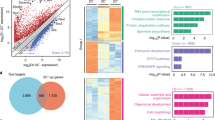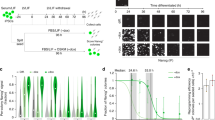Abstract
Arising from: S. K. Singh, M. N. Kagalwala, J. Parker-Thornburg, H. Adams & S. Majumder Nature 453, 223–227 (2008)10.1038/nature06863; Singh et al. reply
Establishment and maintenance of the pluripotent state of ESCs is a key issue in stem cell biology and regenerative medicine, and consequently identification of transcription factors that regulate ESC pluripotency is an important goal. Singh et al.1 claim that the transcriptional repressor REST is such a regulator and that a 50% reduction of REST in ESCs leads to activation of a specific microRNA, miR-21, and that this subsequently results in loss of pluripotency markers and a reciprocal gain in some lineage-specific differentiation markers. In contrast, we show that, in haplodeficient Rest+/- ESCs, we detected no change in pluripotency markers, no precocious expression of differentiated neuronal markers and no interaction of REST with miR-21. It is vital that identification of factors that regulate pluripotency is based on robust, consistent data, and the contrast in data reported here undermines the claim by Singh et al.1 that REST is such a regulator.
This is a preview of subscription content, access via your institution
Access options
Subscribe to this journal
Receive 51 print issues and online access
$199.00 per year
only $3.90 per issue
Buy this article
- Purchase on Springer Link
- Instant access to full article PDF
Prices may be subject to local taxes which are calculated during checkout

Similar content being viewed by others
References
Singh, S. K., Kagalwala, M. N., Parker-Thornburg, J., Adams, H. & Majumder, S. REST maintains self-renewal and pluripotency of embryonic stem cells. Nature 453, 223–227 (2008)
Loh, Y. H. et al. The Oct4 and Nanog transcription network regulates pluripotency in mouse embryonic stem cells. Nature Genet. 38, 431–440 (2006)
Chen, Z. F., Paquette, A. J. & Anderson, D. J. NRSF/REST is required in vivo for repression of multiple neuronal target genes during embryogenesis. Nature Genet. 20, 136–142 (1998)
Johnson, R. et al. REST regulates distinct transcriptional networks in embryonic and neural stem cells. PLoS Biol. 6, e256 (2008)
Otto, S. J. et al. A new binding motif for the transcriptional repressor REST uncovers large gene networks devoted to neuronal functions. J. Neurosci. 27, 6729–6739 (2007)
Johnson, D., Mortazavi, A., Myers, R. & Wold, B. Genome-wide mapping of in vivo protein–DNA interactions. Science 316, 1497–1502 (2007)
Morin, R. et al. Application of massively parallel sequencing to microRNA profiling and discovery in human embryonic stem cells. Genome Res. 18, 610–621 (2008)
Zuccato, C. et al. Huntingtin interacts with REST/NRSF to modulate the transcription of NRSE-controlled neuronal genes. Nature Genet. 35, 76–83 (2003)
Johnson, R. et al. A microRNA-based gene dysregulation pathway in Huntington’s disease. Neurobiol. Dis. 29, 438–445 (2008)
Ying, Q. L. & Smith, A. G. Defined conditions for neural commitment and differentiation. Methods Enzymol. 365, 327–341 (2003)
Wei, C. L. et al. A global map of p53 transcription-factor binding sites in the human genome. Cell 124, 207–219 (2006)
Author information
Authors and Affiliations
PowerPoint slides
Rights and permissions
About this article
Cite this article
Buckley, N., Johnson, R., Sun, YM. et al. Is REST a regulator of pluripotency?. Nature 457, E5–E6 (2009). https://doi.org/10.1038/nature07784
Received:
Accepted:
Issue Date:
DOI: https://doi.org/10.1038/nature07784
This article is cited by
-
REST, regulated by RA through miR-29a and the proteasome pathway, plays a crucial role in RPC proliferation and differentiation
Cell Death & Disease (2018)
-
REST is a crucial regulator for acquiring EMT-like and stemness phenotypes in hormone-refractory prostate cancer
Scientific Reports (2017)
-
RE-1 silencing transcription factor (REST): a regulator of neuronal development and neuronal/endocrine function
Cell and Tissue Research (2015)
-
NRSF: an Angel or a Devil in Neurogenesis and Neurological Diseases
Journal of Molecular Neuroscience (2015)
-
miRNA-21 is developmentally regulated in mouse brain and is co-expressed with SOX2 in glioma
BMC Cancer (2012)
Comments
By submitting a comment you agree to abide by our Terms and Community Guidelines. If you find something abusive or that does not comply with our terms or guidelines please flag it as inappropriate.



